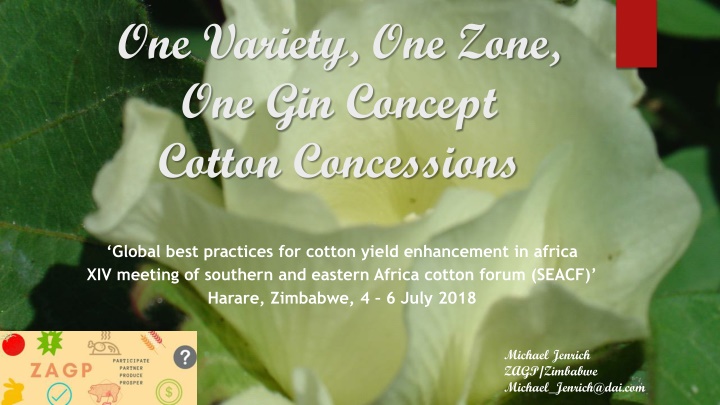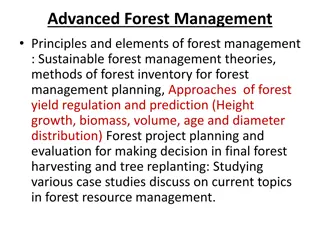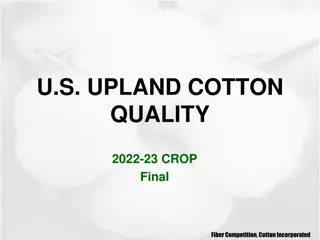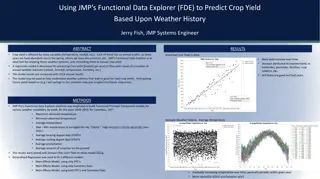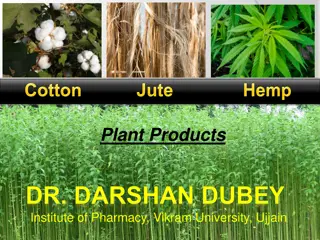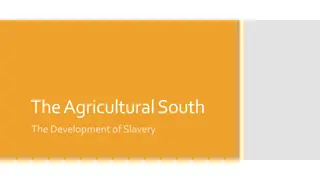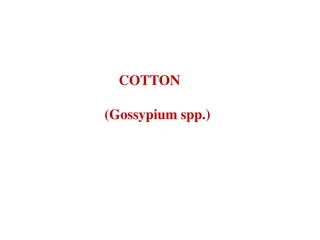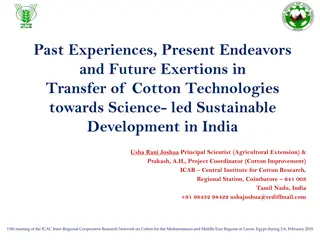Enhancing Cotton Yield in Africa - Best Practices
Sub-Saharan Africa plays a significant role in cotton production, with smallholder farmers cultivating the crop. Contract farming offers benefits to all parties involved but comes with challenges in cost recovery and monitoring. Investment in support systems is vital for sustainability and market growth.
Download Presentation

Please find below an Image/Link to download the presentation.
The content on the website is provided AS IS for your information and personal use only. It may not be sold, licensed, or shared on other websites without obtaining consent from the author.If you encounter any issues during the download, it is possible that the publisher has removed the file from their server.
You are allowed to download the files provided on this website for personal or commercial use, subject to the condition that they are used lawfully. All files are the property of their respective owners.
The content on the website is provided AS IS for your information and personal use only. It may not be sold, licensed, or shared on other websites without obtaining consent from the author.
E N D
Presentation Transcript
One Variety, One Zone, One Gin Concept Cotton Concessions Global best practices for cotton yield enhancement in africa XIV meeting of southern and eastern Africa cotton forum (SEACF) Harare, Zimbabwe, 4 6 July 2018 Michael Jenrich ZAGP/Zimbabwe Michael_Jenrich@dai.com
Background 10 % of the world s cotton is grown in Sub-Saharan Africa (world s fourth largest cotton exporter following the USA, India and Uzbekistan). The Sahel states along the southern belt of the Sahara alone generate $1.5 billion each year by exporting cotton, which accounts for up to 35-75% of the agricultural export earnings in this region In western and southern Africa, cotton is cultivated exclusively by smallholder farmers (3 million in number). 18 million people in Sub-Saharan Africa (SSA) live either directly or indirectly from cotton farming.
Cotton Production System Cotton (Africa) small holder crop Production support from Buyers (Ginners), contract production Based on given market and production contracts Support through: Inputs (seed & crop chemicals) Technical support (extension) Input costs are recovered through sale Depending on farmers delivering to contracted (and supporting company)
Contract Farming, Advantages To Farmers: Receive inputs and advisory support that need to increase their productivity increased income from cotton. To Ginners: Production is ensured and ginners are able to source the cotton that they require. Quality can be improved, as ginners can concentrate on their (contracted) farmers To Country: Increased cotton production increases export earnings; more high quality cotton to boost local textile industry; better quality cotton lint means price rises.
Cotton Production System, Challenges Ensuring the recovery of costs is crucial for the systems to continue If produce is not delivered to the contracting company, they cant recover costs and support ceases Buyer who don't invest in inputs and farmers support can pay higher prices Side selling will undermine and system collapse Large number of farmers and buyers makes control and contract monitoring and enforcement difficult and costly
Potential Market and Support Set Up As production and productivity depends on support, the investments need to be safeguarded and encourage increasing in investments Companies investing in production need to be certain the receive cotton, through, e.g.: Growing contract are adhered and can be enforced Companies that do not support farmers can t get buying licence Central buying system (were all commodities is traded) and companies get their investment back Concession set up, were (One Zone, One Gin Concept) only 1 ginner would be allowed (accredited) to operate in defined areas
Mozambique/Tanzania Mozambique cotton production is unique in the region, entirely being based on a concession system. The cotton sector operates in a monopsony system (demand side), where ginning companies are granted concession (provinces) rights as exclusive buyers of cottonseed in their respective areas of concession Overall set up is controlled an monitored by government Tanzania is investigating district concession As district are easier form an administrative point of view Single district are easier to monitor/control side selling less leakage at marketing time Makes the concession more attractive to bidders thereby potentially getting better offers
Concessions (e.g. Mozambique) Exclusive right to purchase all cotton grown within the concession area Support in organizing district and village task forces and farmer business groups Support to buyers in recovering loans Minimum input/extension package provided to all registered cotton farmers Extension training support offered (compulsory to get concession) Minimum price set to ensure that farmers receive fair market price Prepared to buy all cotton offered for at least the minimum buying price Seed and crop chemical supplied to farmers Other inputs such as fertiliser, herbicide, improve tools etc Additional offers could be phased in over time if contracts are holding
Multi-Year Concession Allows ginners to commit to longer term investments (e.g. extension services, tillage services, fertiliser etc.) Area and production specific support and research, e.g. seed, fertilizer, tillage, longer term support (rotation, groups, credits, etc.) Link with service providers, banks, tillage, other commodities Better and stronger relationships of trust built between ginners and farmers e.g. less likelihood of loan default Ginners can buffer bad seasons and be forgiving on loan recovery (e.g. in drought) if they can roll these forward to the next season. Ginners can commit to increased service offering on a year by year basis Ginners can plan their businesses better and make investments and forward contracts with buyers accordingly knowing that they are guaranteed throughput
Summary Technical and input provision for cotton production is essential to ensure productivity and viability to producers and buyers Safeguarding and return of the investment is central to support Individual control set ups (contract supervision and enforcement) are costly and complex Control and registration of all buyers is challenging and costly Controlled systems from field to gin can ensure investment and viability for producers and buyers Price and service monitoring systems would need to ensure fair trading Tendered and monitored concession set ups with exclusive production and purchasing based on investment (Gin, infrastructure and support) would ensure need investment in production and productivity Transparent and effective monitoring an enforcing (public, association etc.) are pivotal
